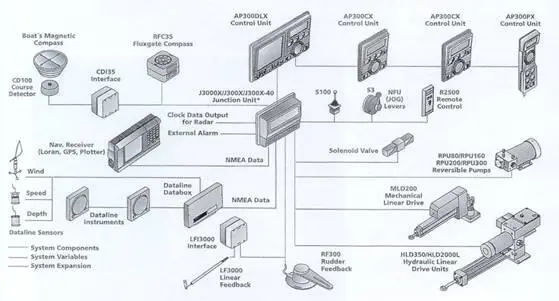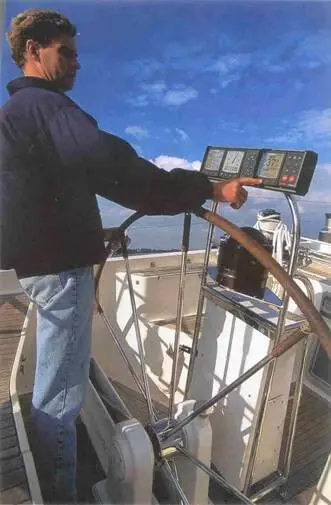 Module integration options with ROBERTSON
Module integration options with ROBERTSON
Today most autopilots operate as one module within a complex system. NMEA (National Marine Electronics Association) interfaces offer the prospect of expanding such a system to include instruments from other manufacturers. In reality, however, the claim that instruments from different system suppliers can communicate with each other using the same interfaces has proven to be something of a fallacy. There are, as many sailors have already discovered to their cost, several standards in existence even for NMEA interfaces. Of course no instrument manufacturer is to blame for any incompatibility; serious communication problems are always the fault of the instrument on the other side of the interface!
Provided with a fluxgate compass signal optimised by integrated navigation modules, an autopilot is perfectly capable of steering a boat from waypoint to waypoint - assuming of course that the wind decides to cooperate.
 Navigating down below with the AUTOHELM NAVPLOTTER 100
Navigating down below with the AUTOHELM NAVPLOTTER 100
Almost all autopilots can be linked to a windvane transducer. This enables them to take the apparent wind angle signal as steering impulse. The signal comes either from the masthead unit or from a small windvane at the stern. Neither alternative produces particularly satisfactory results in any kind of swell, since the movements of the masthead unit caused by the motion of the boat or the confused readings of the stern-mounted unit caused by disturbed air have to be damped and processed considerably to obtain a useful signal. The small size of autopilot windvanes often contributes to such problems.
The volume of data required to produce precise and practicable course commands for the steering module when using the course computer to calculate the apparent wind angle is substantial: rolling, pitching, speed, acceleration, wind angle and possibly also true parameters (true wind angle etc.) must all be processed. The importance of sailing to the apparent wind angle cannot be understated; ignore it and the boat loses all its drive.
The power consumption of an autopilot is determined not only by the rating of the model chosen but also by the following factors:
a. Length and displacement of the vessel
The more boat there is to move, the greater the power consumption.
A keel-mounted rudder requires more force because it is impossible to balance. A rudder on a skeg can have a balance portion below the skeg and is therefore easier to steer. A fully balanced spade rudder without a skeg is lightest on the helm.
c. Speed with which corrective rudder movements must be made
This depends on how well the boat holds a course, and is therefore also influenced by its shape below the waterline.
d. Sail trim, weather helm
Poorly trimmed sails and continuous weather helm are always more of a drain on the autopilot than a well-balanced boat.
Bigger seas and increased yawing require more frequent steering interventions by the autopilot.
f. Desired steering precision
The more exactly the course must be held, the greater the amount of work there is for the autopilot.
Optimising the vessel with respect to the above points can considerably reduce average power consumption. Once this has been done, the only remaining measure is to reduce the frequency of course corrections. This amounts in practice to increasing the angle by which the boat may deviate from the set course before the autopilot responds, in other words allowing the boat a greater range of movement between active steering interventions.
All modern autopilots are programmed to recognise certain regular patterns of yawing. This helps them shorten their operating cycle and reduce the length of time for which the motor is running. It also enables them promptly to correct the course early on in a recurrent motion, so avoiding more vigorous rudder movements later on. Unfortunately we have now reached the end of the list of power saving measures.
The manufacturers base their average power consumption figures on a 25% operating cycle. This assumes in terms of actual autopilot running time that per hour the boat is actively steered for 15 minutes and holds itself on course with no action at all from the helm for the other 45 minutes. These figures may seem just a little optimistic; actual power consumption, therefore, will often be higher.
Fitting out for an extended voyage really brings home the gulf between the theory and practice of power consumption. Energy management is essential here since all the power consumed on board must first be generated on board. The difference between the manufacturers’ rated average power consumption and the actual autopilot motor running time can be enormous; real situations are never ‘average’ and the actual power consumption is always higher. A boat equipped with just a depth sounder, a handheld GPS, paraffin cabin lights, a windvane steering system and without an ice box - that is to say one whose power consumption is reduced to the minimum - will hardly ever run its batteries close to exhaustion. This boat does not, however, bear much resemblance to the average passage yacht. The ARC fleet which passes through the Canaries every Autumn shows a clear trend: in the last 10 years alone the average length of participating yachts has grown to around 44 feet while the number of sub-33 footers has dwindled to barely a handful. The boats are generally equipped to a very high standard as well, with most carrying navigation instruments such as GPS, plotters and radar, short wave, SSB and VHF radios, refrigerator, pumps, water maker and interior and exterior lights.
Combining the 24 hour average power consumption of each of these appliances for a 44 foot boat in warmer latitudes gives a total of 120 ampere-hours (Ah) - even without an electric autopilot running. This example clearly illustrates the care needed in budgeting for energy aboard a sailing yacht. The impact of an autopilot on this energy budget is very substantial, particularly if the system has been chosen for its high performance rather than low power consumption. There are whole books devoted solely to the subject of energy management on board: pay too little heed to this complex issue before you cast off and you can count on a nasty reminder somewhere out at sea.
 Navigating on deck with AUTOHELM
Navigating on deck with AUTOHELM
The manufacturer’s recommended autopilot for our exemplary 44 foot boat draws between 2.7 and 6 A per hour, which means that if run continuously it will push up the vessel’s total power consumption by at least another 50% over a 24 hour period. We should also bear in mind here that some units in the vessel’s electrical system will fail if the voltage falls below 10.5 V. Against this background a seemingly large battery capacity of 600 Ah begins to look less impressive.
Wind, water, wave and solar generators can help but depending on the conditions even these are no guarantee against a few hours of enforced motoring every day (as well-known circumnavigator and race organiser Jimmy Cornell confirmed after debriefing skippers at the end of his EUROPA 92 race). Whenever one of the additional generators malfunctions or fails, increased engine running time inevitably results. Without good sound-proofing, the iron sail can rapidly become an unwelcome intrusion into life aboard. The extra heat from the engine is often a bonus as well, just right to ease the afternoon chill in Bermuda...
Читать дальше

 Module integration options with ROBERTSON
Module integration options with ROBERTSON Navigating down below with the AUTOHELM NAVPLOTTER 100
Navigating down below with the AUTOHELM NAVPLOTTER 100 Navigating on deck with AUTOHELM
Navigating on deck with AUTOHELM









